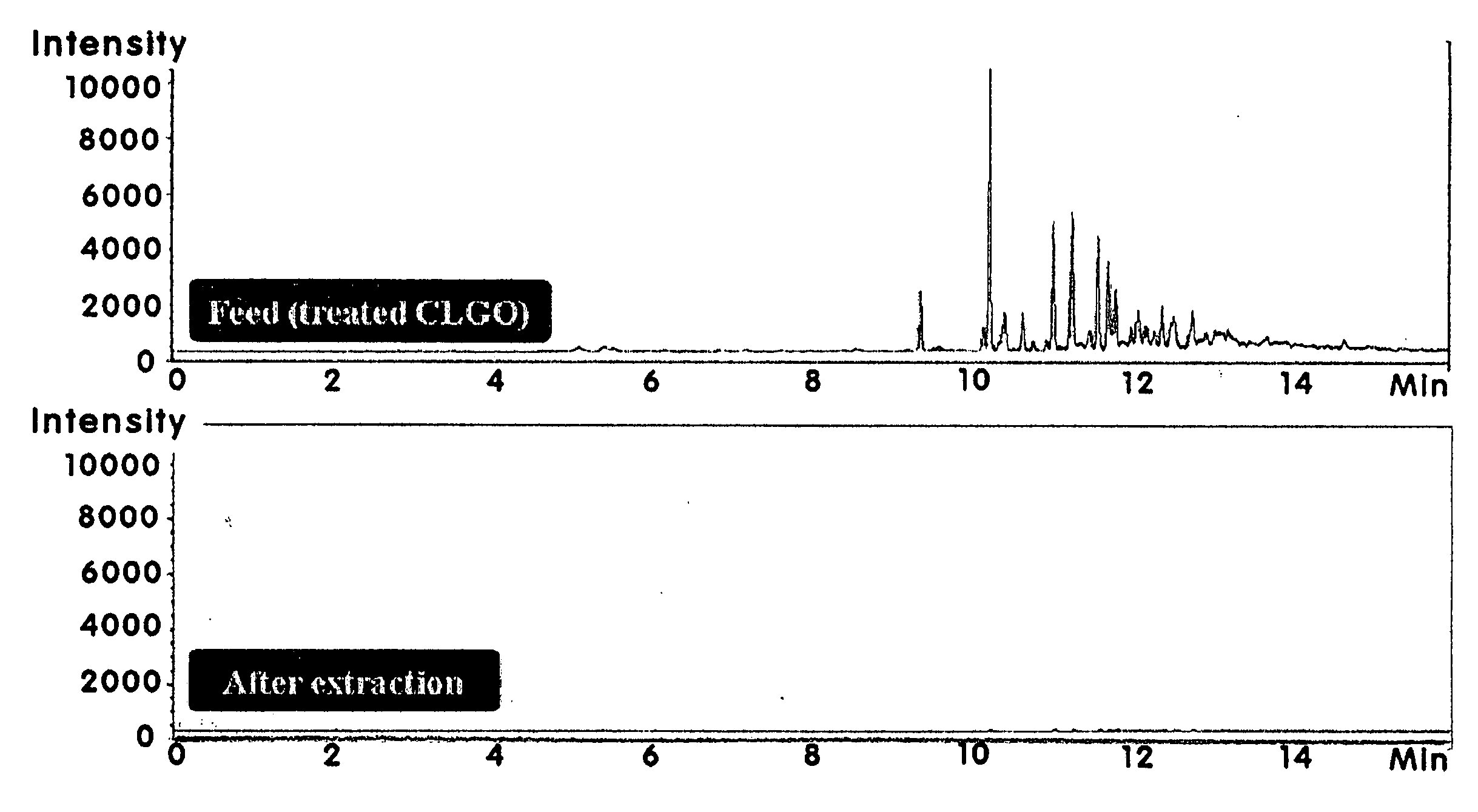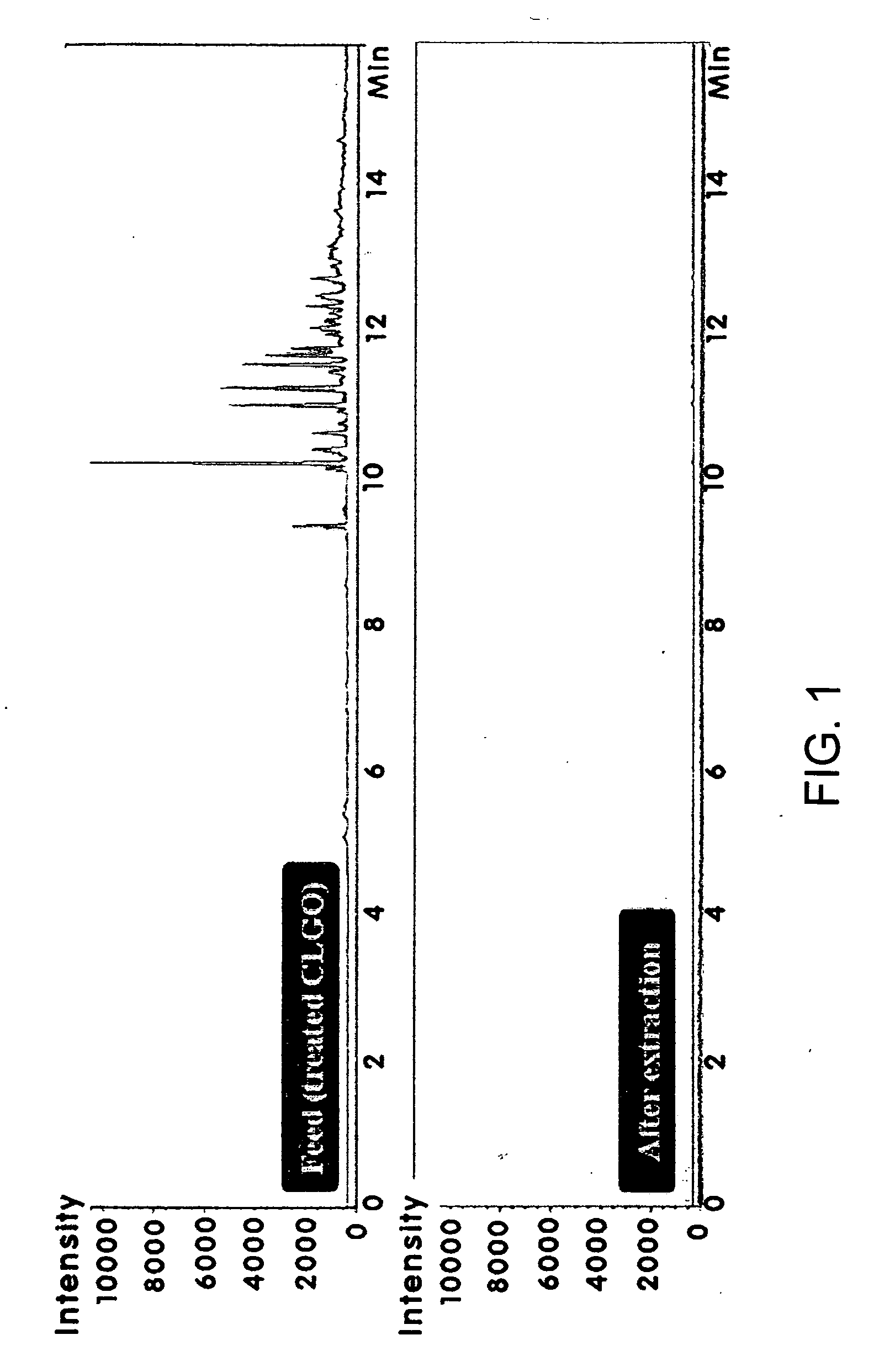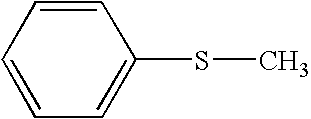Process for the reduction of sulfur, nitrogen and the production of useful oxygenates from hydrocarbon materials via one-pot selective oxidation
a technology of selective oxidation and hydrocarbon materials, which is applied in the preparation of carboxylic compounds, organic chemistry, refining with metals, etc., can solve the problems of excessive hydrogenation of essential hydrocarbon components such as olefins, paraffin and aromatics including multi-ring compounds, and become increasingly difficult to remove from the hydrocarbon fraction of petroleum
- Summary
- Abstract
- Description
- Claims
- Application Information
AI Technical Summary
Benefits of technology
Problems solved by technology
Method used
Image
Examples
example 1
Selective Oxidation of Indole (N-Compound)
[0072]Nitrogen-containing compounds present in petroleum may be divided into 3 classes: (i) aliphatic and aromatic amines, (ii) pyrrole-type acidic N-compound and (iii) pyridine-type basic N-compound. Among them, indole was used in this Example.
[0073]Selective oxidation was conducted by using indole (99%, Aldrich) as a nitrogen model compound and acetic acid (glacial, 99.8%, Aldrich) as a solvent in the presence of Co / Mn / HBr catalyst, which was prepared using Co(OAc)2.4H2O (98%, Aldrich), Mn(OAc)2.4H2O (99%, Aldrich) and HBr (48%, Aldrich) in a Ti-autoclave for 2 hours under the conditions of 10 atm, 150° C. and 350 rpm, while introducing O2 / CO2 (30% / 70%).
[0074]Analysis of products using GC-MS (Agilent 5973I) and GC-FID (Agilent 6890N) shows that nitrogen-containing substrate was completely oxidized and undetectable at one hour time point of the experiment.
example 2
Selective Oxidation of Tetralin (Benzylic Compound)
[0075]Examples of benzylic hydrocarbon present in petroleum resids, in particular hydrotreated petroleum resids are alkyl derivative (n-, iso, tertiary) of benzene and naphthalene, partially hydrogenated condensed multi-ring compound, tetralin, naphthenes, octalin, dihydronaphthalene, dihydroindole, cyclohexylbenzene, alkyl derivative (n-, iso-tertiary) thereof, naphthocycloparaffin and alkyl derivative (n-, iso, tertiary) thereof.
[0076]Among the oxygenates known as an excellent cetane or octane booster as shown below, 1,4-naphthoquinone, which is easily produced according to the present invention, has twice more amount of oxygen than α-tetralone, thus being superior in enhancing cetane or octane number. Further, the compound also remarkably reduces the production of particulate matters (PM), NOx and SOx.
Formulas: Oxygenates known as an excellent cetane or octane booster
[0077]Among the aforementioned benzylic hydrocarbon, tetralin w...
example 3
Selective Oxidation of Synthetic Model Compounds Feeds
(1) Preparation of Synthetic Model Compounds Feeds
[0082]Examples of hydrocarbon substrate appropriate for this experiment are FCC products such as LCN (41-129° C.), HCN (129-204° C.), distillate (204-338° C.), LCO (329-385° C.), CLO (clarified oil) (360-650° C.) and particularly transportation fuel (e.g., gasoline and diesel).
[0083]Synthetic model compounds feeds similar to the aforementioned hydrocarbon substrate are prepared as in Table 5 by using sulfur component, nitrogen component and benzylic hydrocarbon, specifically n-decane (99%, Aldrich), n-hexadecane (99%, Aldrich), DBT (dibenzothiophene, 98%, Aldrich), 4,6-DMDBT (4,6-dimethyl dibenzothiophene, 97%, Aldrich), tetralin (99%, Aldrich) and indole (99%, Aldrich).
TABLE 5DBT4,6-DMDBTTetralinIndoleTotaln-Decanen-Hexadecane(ppm / mmol)(ppm / mmol)(ppm / mmol)(ppm / mmol)100 g48.975 g48.975 g0.500 g0.500 g1.000 g0.050 g(5,000 / 2.69)(5,000 / 2.28)(10,000 / 7.49)(500 / 0.42)
(2) Selective Oxidat...
PUM
| Property | Measurement | Unit |
|---|---|---|
| Temperature | aaaaa | aaaaa |
| Pressure | aaaaa | aaaaa |
| Fraction | aaaaa | aaaaa |
Abstract
Description
Claims
Application Information
 Login to View More
Login to View More - R&D
- Intellectual Property
- Life Sciences
- Materials
- Tech Scout
- Unparalleled Data Quality
- Higher Quality Content
- 60% Fewer Hallucinations
Browse by: Latest US Patents, China's latest patents, Technical Efficacy Thesaurus, Application Domain, Technology Topic, Popular Technical Reports.
© 2025 PatSnap. All rights reserved.Legal|Privacy policy|Modern Slavery Act Transparency Statement|Sitemap|About US| Contact US: help@patsnap.com



